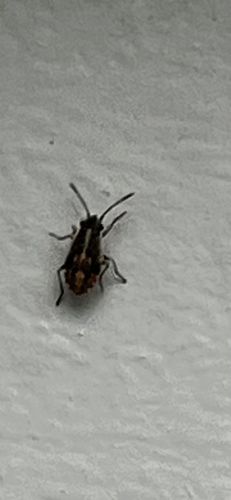Brown Marmorated Stink Bug (young nymph)
Scientific Name: Halyomorpha halys
Order & Family: Hemiptera, Pentatomidae
Size: Nymphs vary in size from approximately 2.4 mm (1st instar) to 12-17 mm (5th instar/adult). The individual in the image appears to be a very young nymph, likely 1st or 2nd instar.

Natural Habitat
Agricultural fields, orchards, gardens, residential homes, and wooded areas. Often found on host plants like fruits, vegetables, and ornamentals.
Diet & Feeding
Polyphagous herbivore. Nymphs and adults feed on a wide variety of plant hosts, including many fruits (apples, peaches, berries), vegetables (corn, tomatoes, peppers), and ornamental plants, by piercing the plant tissue with their stylets and sucking out plant juices.
Behavior Patterns
Nymphs typically remain on host plants, molting through five instars before reaching adulthood. They are often found aggregated on preferred host plants. As they mature, they transition from a dark, ant-like appearance to more closely resemble the adult form. Adults are known for overwintering indoors in homes and other structures, and they emit a foul-smelling odor when disturbed.
Risks & Benefits
Potential risks: Considered a significant agricultural pest due to its wide host range and feeding damage, which can lead to economic losses for farmers. It can also be a nuisance pest in homes when adults seek shelter indoors during colder months. Potential benefits: None widely recognized, it is primarily known for its invasive and pestiferous nature.
Identified on: 9/6/2025